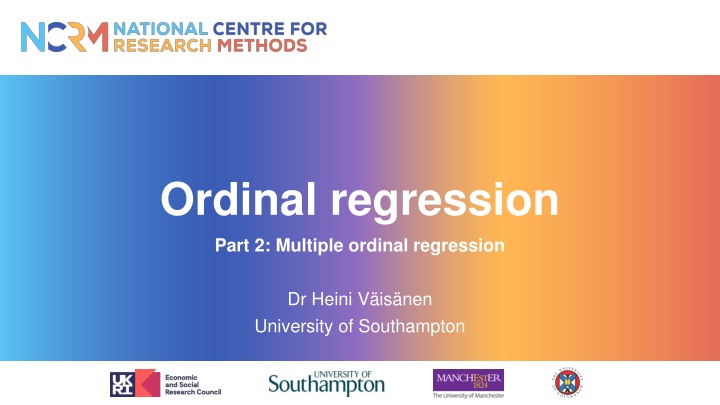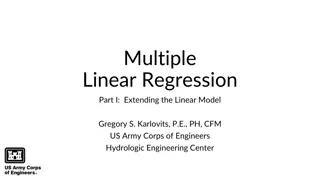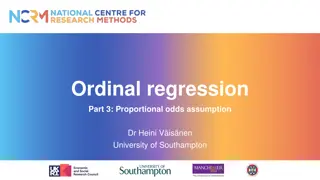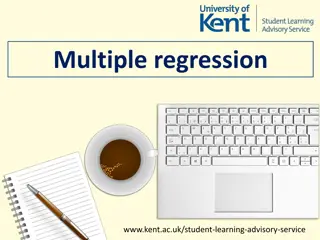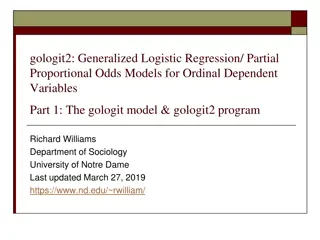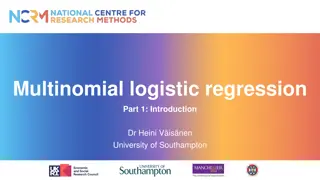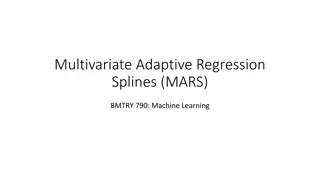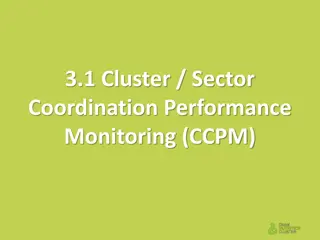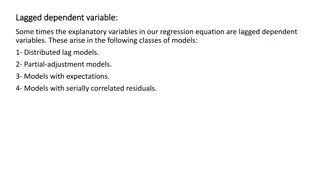Multiple Ordinal Regression Models for Gender and Education Associations
Explore multiple ordinal regression models analyzing the associations of gender and education with fear of crime in England and Wales. Understand the differences in interpretation compared to other regression models due to the cumulative nature of the model.
Download Presentation

Please find below an Image/Link to download the presentation.
The content on the website is provided AS IS for your information and personal use only. It may not be sold, licensed, or shared on other websites without obtaining consent from the author.If you encounter any issues during the download, it is possible that the publisher has removed the file from their server.
You are allowed to download the files provided on this website for personal or commercial use, subject to the condition that they are used lawfully. All files are the property of their respective owners.
The content on the website is provided AS IS for your information and personal use only. It may not be sold, licensed, or shared on other websites without obtaining consent from the author.
E N D
Presentation Transcript
Ordinal regression Part 2: Multiple ordinal regression Dr Heini V is nen University of Southampton
Outline Multiple ordinal regression model Statistical significance Interpretation of the results Cumulative odds ratios Predicted probabilities
Multiple ordinal regression models Like other regression models, ordinal regression can include many explanatory variables You might want to control for some variables when investigating the associations of others Interpretation slightly different from other regression models due to the cumulative nature of the model
Example: Fear of crime How worried are people in England and Wales about their homes being broken into? Does this vary by gender and education? Data source: Crime Survey for England and Wales Office for National Statistics, University of Manchester. Cathie Marsh Institute for Social Research (CMIST). UK Data Service. (2016). Crime Survey for England and Wales, 2013- 2014: Unrestricted Access Teaching Dataset. [data collection]. UK Data Service. SN: 8011, http://doi.org/10.5255/UKDA-SN-8011-1
Descriptive statistics: how worried about burglary Category % N 1) Not at all worried 15.2 331 2) Not very worried 47.5 1036 3) Fairly worried 27.1 590 4) Very worried 10.3 224 TOTAL 100.0 2181
Descriptive statistics: gender and education Category % N Category % N Men 45.3 988 None 25.7 561 Women 54.7 1193 O-level/GCSE 18.6 406 TOTAL 100.0 2181 A-level 18.4 401 Degree or diploma TOTAL 37.3 813 100.0 2181
Ordinal regression results (CORs) Variable Men (ref.) Women No education (ref.) O-level/GCSE A-level Degree or diploma COR 1.00 1.35 1.00 0.99 0.81 0.72 P-value CI 95% <0.001 1.15-1.59 0.907 0.082 0.002 0.77-1.25 0.63-1.03 0.59-0.88 Cutpoint 1 -1.74 Cutpoint 2 0.52 Cutpoint 3 2.18
Statistical significance: Wald-test Variable Men (ref.) Women No education (ref.) O-level/GCSE A-level Degree or diploma COR 1.00 1.35 1.00 0.99 0.81 0.72 P-value CI 95% <0.001 1.15-1.59 0.907 0.082 0.002 0.77-1.25 0.63-1.03 0.59-0.88 Cutpoint 1 -1.74 Cutpoint 2 0.52 Cutpoint 3 2.18
Interpretation: cumulative odds ratios Women have 35% higher odds of being in higher rather than lower categories of the outcome, that is they are more likely to be worried, when controlling for education. Variable Men (ref.) Women No education (ref.) O-level/GCSE A-level Degree or diploma COR 1.00 1.35 1.00 0.99 0.81 0.72
Interpretation: cumulative odds ratios More educated groups are less likely to be in the higher rather than lower categories of the outcome, that is they are less likely to be worried, when controlling for gender. E.g. odds are 28% lower among those with a degree than those without education. Variable Men (ref.) Women No education (ref.) O-level/GCSE A-level Degree or diploma COR 1.00 1.35 1.00 0.99 0.81 0.72
Interpretation: predicted probabilities exp(?? ??) 1 + exp(?? ??) ???= Variable Cumulative logit 0.00 0.30 0.00 Not at all worried vs. higher categories, women, A-level: ??1 exp( 1.74 0.30 + 0.22) 1 + exp( 1.74 0.30 + 0.22) = 0.138 Men (ref.) Women No education (ref.) O-level/GCSE A-level Degree or diploma -0.01 -0.22 -0.33 = Cutpoint 1 -1.74 Cutpoint 2 0.52 Cutpoint 3 2.18
Interpretation: predicted probabilities exp(?? ??) 1 + exp(?? ??) ???= Variable Cumulative logit 0.00 0.30 0.00 Not at all worried vs. higher categories, women, A-level: ??2= 0.606 ??3= 0.890 ??4= 1 Men (ref.) Women No education (ref.) O-level/GCSE A-level Degree or diploma -0.01 -0.22 -0.33 Cutpoint 1 -1.74 Cutpoint 2 0.52 Cutpoint 3 2.18
Interpretation: predicted probabilities exp(?? ??) 1 + exp(?? ??) ???= Variable Cumulative logit 0.00 0.30 0.00 Not at all worried vs. higher categories, women, A-level: ??1= ?1= 0.138 ?2= ??2 ?1= 0.468 ?3= ??3 ??2= 0.284 ?4= ??4 ??3= 0.11 Men (ref.) Women No education (ref.) O-level/GCSE A-level Degree or diploma -0.01 -0.22 -0.33 Cutpoint 1 -1.74 Cutpoint 2 0.52 Cutpoint 3 2.18
Interpretation: predicted probabilities of being (a) not at all worried or (b) very worried by gender
